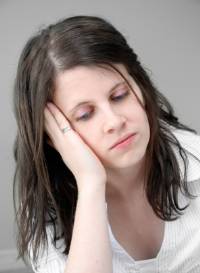It’s not just men who experience hormone-related hair loss. Women’s hair loss can also be cause by hormones. In men, overproduction of male hormones or androgens has a disastrous effect on the hair follicles. This is called androgenic alopecia and results in permanent hair loss. Women can also suffer from this condition, although they rarely become bald. In women, diffuse, over-all hair thinning occurs, generally most noticeable around the forehead and crown of the scalp. The individual hair shaft’s diameter decreases as well. But how can androgens (male hormones) affect women’s hair loss?
Click Here To Learn More About Women’s Hair Loss!
Female pattern hair loss usually begins with the onset of menopause. Estrogen levels begin to decline and it is estrogen that is a critical factor here. Estrogen blocks the action of the hormone indirectly responsible for women’s hair loss. Testosterone is present even in women’s bodies. Without significant levels of estrogen to inhibit it, testosterone is converted into dihydrotestosterone (DHT) by the action of an enzyme named 5-alpha reductase. Some hair follicles are especially susceptible to the action of DHT. When attacked by DHT, the growth cycle of the follicle is disrupted. It begins to shrink and miniaturize, producing thinner and thinner hair with each cycle. Eventually, the hair falls out and does not regrow.
In a normal scalp, when a hair falls out and a new young hair pushes up from the base of the follicle to replace it. Under the action of DHT the follicle ceases to produce hair. To stop or reverse women’s hair loss, either the action of DHT needs to be blocked or the follicle needs to be stimulated to overcome the attack and regrow hair. For women, blocking DHT is accomplished by estrogen replacement therapy — typically by prescribing an estrogen-dominant birth control pill. But estrogen can put some women at risk for breast cancer. If you don’t want to go the hormone route, Rogaine® works to stimulate the follicles. Known as a “potassium channel opener,” the main ingredient in Rogaine® is minoxidil, a drug clinically proven to stimulate hair growth. Minoxidil is topically applied and you must continue using it or the benefits will reverse.
In pregnancy-related women’s hair loss, estrogen is also involved. During pregnancy, estrogen levels rise. Researchers think that higher levels of this hormone prolong the hair’s growing or anagen phase, preventing the woman from shedding any hairs. Pregnant women often report thicker, healthier hair during this time. After the baby is delivered and the estrogen levels in the body begin to return to normal, the abnormally-prolonged growing phase of the hair naturally terminates. The result is that a large proportion of hairs enter the dormant or telogen phase. The hair stops growing, enters an inactive state and eventually falls out. Fortunately this condition is temporary. Your hair will appear thin for a few months, but eventually the follicles will produce strong new hair.
Women’s hair loss in the case of menopause or pregnancy is either temporary or treatable. Recognized and tested solutions exist for hormone-related hair loss in women.

